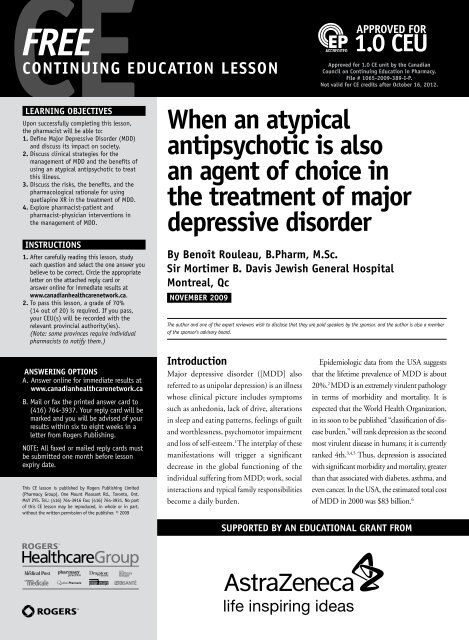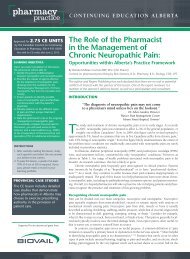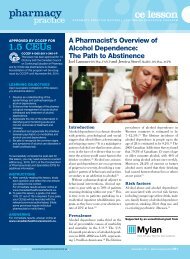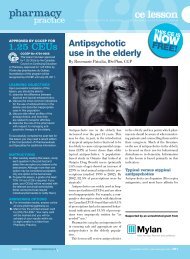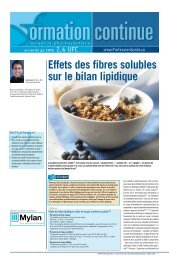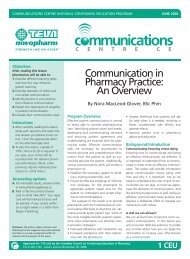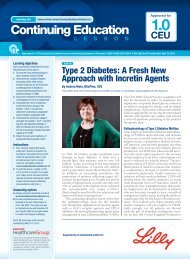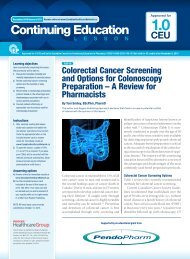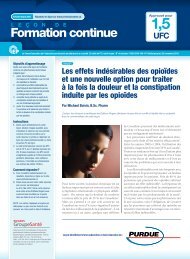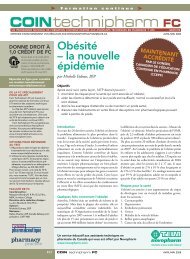When an atypical antipsychotic is also an agent - Canadian ...
When an atypical antipsychotic is also an agent - Canadian ...
When an atypical antipsychotic is also an agent - Canadian ...
- No tags were found...
You also want an ePaper? Increase the reach of your titles
YUMPU automatically turns print PDFs into web optimized ePapers that Google loves.
gic 1 receptors (H 1 ), hence one c<strong>an</strong> expectsedation <strong>an</strong>d weight gain. The medicalliterature shows that quetiapine XR <strong>is</strong> associatedwith a lower intensity of self-reported“excessive sedation” compared with theimmediate-release formulation. 27 Interestingly,quetiapine’s low affinity for serotonergic5HT 2C <strong>an</strong>d muscarinic 3 (M 3 ) receptors<strong>is</strong> thought to limit the weight gainpredicted by blockade of H 1 receptors.Quetiapine’s <strong>an</strong>ticholinergic (M 1 ) effectsare weak which might explain why it has minimaldetrimental effects on cognitive function.Clinically, th<strong>is</strong> attribute <strong>is</strong> relev<strong>an</strong>t as m<strong>an</strong>ypatients suffering from MDD are cognitivelyimpaired (concentration, attention, etc.) 8Akin to all <strong>an</strong>tipsychotics, quetiapine hasthe capacity to block postsynaptic dopamine 2receptors (D 2 ). In contrast to other <strong>agent</strong>s suchas r<strong>is</strong>peridone or paliperidone that bind tightlyto these receptors, quetiapine (like clozapine)<strong>is</strong> considered a loose binder. It <strong>is</strong> thought thatloose binders are associated with a lower incidenceof extrapyramidal symptoms <strong>an</strong>d tardivedyskinesia, dysphoria <strong>an</strong>d prolactin-relatedside effects (osteoporos<strong>is</strong>, amenorrhea, sexualdysfunction, etc.) th<strong>an</strong> tight binders. 28,29Atypical <strong>an</strong>tipsychotics block the postsynapticserotonergic 5HT 2 receptors. Some<strong>an</strong>tidepress<strong>an</strong>ts, such as mirtazapine, are <strong>also</strong><strong>an</strong>tagon<strong>is</strong>ts of th<strong>is</strong> neuronal system. Stimulationof the postsynaptic 5HT 2 receptors c<strong>an</strong>trigger various clinical problems that areoften seen with SSRIs, venlafaxine, desvenlafaxineor duloxetine. These include sleepd<strong>is</strong>ruption, <strong>an</strong>xiety, akath<strong>is</strong>ia, agitation, sexualdysfunction, extrapyramidal symptoms,among others. It should <strong>also</strong> be noted thatserotonin (via its action at these receptors)c<strong>an</strong> set off a state of hypodopaminerg<strong>is</strong>m <strong>an</strong>dof hyponoradrenerg<strong>is</strong>m. 30Quetiapine’s affinity for serotonergic 5HT 7receptors could explain its beneficial effectson sleep architecture. 31-33Recent data show that one of quetiapine’smetabolites, norquetiapine (<strong>also</strong> known asN-desalkyl quetiapine), inhibits the norepinephrinereuptake tr<strong>an</strong>sporter, therebypotentiating noradrenaline neurotr<strong>an</strong>sm<strong>is</strong>sion.34 Th<strong>is</strong> attribute <strong>is</strong> shared by m<strong>an</strong>y<strong>an</strong>tidepress<strong>an</strong>ts such as duloxetine, desvenlafaxine,venlafaxine (when used at dosesabove 150–225 mg/day) <strong>an</strong>d most of thetricyclics. The metabolite norquetiapine <strong>also</strong>acts as a partial serotonin 5HT 1A agon<strong>is</strong>t (abuspirone-like effect); a feature that mightexplain the <strong>an</strong>xiolytic effects that c<strong>an</strong> beseen with quetiapine XR. 34,35Clinical studies ofquetiapine in unipolarmajor depressive d<strong>is</strong>orderThe clinical development program thatassessed the efficiency of quetiapine XR as amonotherapy in unipolar major depressived<strong>is</strong>order cons<strong>is</strong>ted of six studies; two of whichhave been publ<strong>is</strong>hed at th<strong>is</strong> time. 36,37Quetiapine XR was effective as a monotherapyfor the treatment of MDD. From atolerability st<strong>an</strong>dpoint, let’s note that quetiapineXR’s safety profile differed from its comparators.For example, in the Cutler et al.study, 36 the most frequent adverse eventsnoticed with quetiapine XR were dry mouth,somnolence <strong>an</strong>d sedation. For duloxetine,which was used as the comparator in th<strong>is</strong> trial,nausea, headache, dizziness <strong>an</strong>d dry mouthwere the most common side effects reported.In the quetiapine XR group, sedation <strong>an</strong>dsomnolence were the adverse events that ledpatients to stop their treatment most often (afinding that was <strong>also</strong> replicated in the We<strong>is</strong>leret al. trial). 37 In the duloxetine group, nausea<strong>an</strong>d sedation caused the majority of tolerability-relatedtreatment terminations. 36 Clinici<strong>an</strong>smust <strong>also</strong> remember that general safety<strong>is</strong>sues of <strong>atypical</strong> <strong>an</strong>tipsychotics such as weightgain, hyperlipidemia, hyperglycemia, tardiveTable 1 Tolerability <strong>is</strong>sues with currently-marketed <strong>an</strong>tidepress<strong>an</strong>ts 8,9,26,31,36,38,42,43SSRIs * SNRIs Mirtazapine Bupropion Quetiapine XRNausea ++++ ++++ 0 0/+ 0/+Sexual dysfunction ++++ ++++ + 0/+ ++Sleep d<strong>is</strong>turb<strong>an</strong>ces ++++ ++++ 0/+ + 0/+Agitation / Anxiety/Restlessness/ Akath<strong>is</strong>ia+++ +++ 0/+ + 0/+Withdrawal symptoms(when drug <strong>is</strong> d<strong>is</strong>continued)• Very common withparoxetine, c<strong>an</strong> besevere• Less common withfluoxetine• Very common withvenlafaxine XR,c<strong>an</strong> be severe• Need more datawith duloxetine0/+Usually mild0/+Usually mild+/++Usually mildNotes : ++++ : very common ; 0 : uncommon; SSRIs: citalopram, escitalopram, paroxetine, sertraline, fluoxetine, fluvoxamine; * : differences might ex<strong>is</strong>t between <strong>agent</strong>s;SNRIs: duloxetine, desvenlafaxine, venlafaxine (when doses are > 150-225 mg/day)November 2009 | Answer online at www.c<strong>an</strong>adi<strong>an</strong>healthcarenetwork.ca <strong>When</strong> <strong>an</strong> <strong>atypical</strong> <strong>an</strong>tipsychotic <strong>is</strong> <strong>also</strong> <strong>an</strong> <strong>agent</strong> of choice in the treatment of major depressive d<strong>is</strong>order | 3
Table 2 Quetiapine XR: dose <strong>an</strong>d titration vs indicationsIndication Target dose Titration CommentsSchizophrenia <strong>an</strong>d M<strong>an</strong>ia400–800 mg/dayMaximal dose in productlabeling: 800 mg/dayday 1: 300 mg/dayday 2: 600 mg/dayafter day 2: up to 800 mg/dayBipolar depression300–600 mg/dayMaximal dose in productlabeling: 600 mg/dayday 1: 50 mg/dayday 2: 100 mg/dayday 3 : 200 mg/dayday 4 <strong>an</strong>d thereafter: 300 mg/dayIn clinical trials, doses of 300 mg/day <strong>an</strong>d of 600 mg/day were evaluated;the optimal dose seems to be300 mg for most patientsUnipolar majordepressive d<strong>is</strong>order50–300 mg/dayTarget dose seems to be150 mg/day in most patientsday 1: 50 mg/dayday 2: 50 mg/dayday 3: 150 mg/dayafter day 4: up to 300 mg/daydyskinesia <strong>an</strong>d neuroleptic malign<strong>an</strong>t syndromemust be taken into account as quetiapineXR <strong>is</strong> a member of th<strong>is</strong> class. 26Quetiapine XR :pharmacokinetics <strong>an</strong>ddrug interactionsQuetiapine XR, a dibenzothiazepine derivative,undergoes a very signific<strong>an</strong>t first-passeffect; its bioavailability being only 9%. TheTmax of the immediate-release formulationof quetiapine (Seroquel ® ) <strong>is</strong> about one hour;for the XR formulation, the Tmax <strong>is</strong> aboutsix hours. CYP3A4 appears to be the main<strong>is</strong>oenzyme involved in the biotr<strong>an</strong>sformationof quetiapine. 26Via CYP3A4, the metabol<strong>is</strong>m of quetiapineyields norquetiapine, a metabolite with <strong>an</strong>tidepress<strong>an</strong>tproperties. Th<strong>is</strong> metabolite has alonger plasma half-life th<strong>an</strong> the parent drug<strong>an</strong>d <strong>is</strong> <strong>also</strong> metabolized by CYP3A4. 34As for clinically relev<strong>an</strong>t pharmacokineticdrug interactions, inhibitors of CYP3A4 c<strong>an</strong>increase quetiapine plasma levels by up to10-fold, <strong>an</strong>d inducers of CYP3A4 c<strong>an</strong> decreasequetiapine plasma levels very subst<strong>an</strong>tially.Table 3 Atypical <strong>an</strong>tipsychotics – indications in C<strong>an</strong>ada (as monotherapy)Quetiapine XR Ol<strong>an</strong>zapine R<strong>is</strong>peridone ZiprasidoneSchizophreniaAcute √ √ √ √Bipolar D<strong>is</strong>order– acute m<strong>an</strong>ia √ √ √ √Bipolar D<strong>is</strong>order– acute depression √Unipolar Major DepressiveD<strong>is</strong>order√Sources: AstraZeneca C<strong>an</strong>ada Inc. Seroquel XR® product monograph. May 27, 2009; Eli Lilly C<strong>an</strong>ada. Zyprexa® productmonograph. February 23, 2009; J<strong>an</strong>ssen-Ortho. R<strong>is</strong>perdal® product monograph. June 30, 2008; Pfizer C<strong>an</strong>ada. Zeldox®product monograph. December 18, 2008.Quetiapine <strong>is</strong> not affected by the smokingstatus of the patient.Quetiapine <strong>is</strong> a substrate of p-glycoprotein.It <strong>is</strong> 83% bound to plasma proteins. Theelimination half-lives of quetiapine <strong>an</strong>dnorquetiapine are approximately seven <strong>an</strong>d12 hours respectively. 26 The relev<strong>an</strong>ce oftherapeutic drug monitoring with quetiapine<strong>is</strong> still a matter of debate.Pharmac<strong>is</strong>t’s rolePatient counsellingPharmac<strong>is</strong>ts must remember that almost halfof all patients stop their <strong>an</strong>tidepress<strong>an</strong>t medicationduring the first month of therapy, <strong>an</strong>dnearly 75% of them do so within the first threemonths.As a community pharmac<strong>is</strong>t, bear in mindthat the depressed patient might not have the“strength” or enough “drive” to pick up h<strong>is</strong>medication at the pharmacy. For some, to just<strong>an</strong>swer the phone <strong>is</strong> a garg<strong>an</strong>tu<strong>an</strong> task.Quetiapine XR tablets should be swallowedwhole <strong>an</strong>d not split, chewed or crushed.Quetiapine XR c<strong>an</strong> be admin<strong>is</strong>tered with orwithout food. The product monograph statesthat quetiapine XR should be admin<strong>is</strong>teredgenerally in the evening (to respect the Tmaxof the formulation).Be vigil<strong>an</strong>t when you h<strong>an</strong>d a patient <strong>an</strong>4 | <strong>When</strong> <strong>an</strong> <strong>atypical</strong> <strong>an</strong>tipsychotic <strong>is</strong> <strong>also</strong> <strong>an</strong> <strong>agent</strong> of choice in the treatment of major depressive d<strong>is</strong>order Answer online at www.c<strong>an</strong>adi<strong>an</strong>healthcarenetwork.ca | November 2009
information sheet because it would be awkwardfor someone receiving quetiapine XR forunipolar depression to read on the patientinformation leaflet: “Th<strong>is</strong> medication has beenprescribed for your psychos<strong>is</strong>”.Here are a few concepts that could beshared with your patients:Even if you start feeling better, do not stopyour quetiapine XR because <strong>an</strong>tidepress<strong>an</strong>tssometimes require m<strong>an</strong>y weeks or months fortheir full effect to be noticeable.Quetiapine XR <strong>is</strong> a psychotropic (i.e., adrug that acts on the brain) with m<strong>an</strong>y clinicaluses, depression being one of them. It <strong>is</strong> <strong>also</strong>very effective against symptoms such as<strong>an</strong>xiety, “inner tension”, restlessness <strong>an</strong>dinsomnia.Even just after a few days, you will noticebeneficial effects of quetiapine XR: you willsleep better <strong>an</strong>d you will feel “less sad”. Butremember that m<strong>an</strong>y weeks or monthsmight be needed for its “full effect” to benoticeable.Clinical pearlsQuetiapine XR, <strong>an</strong> “<strong>an</strong>tipsychotic/<strong>an</strong>tidepress<strong>an</strong>t”,c<strong>an</strong> be used for unipolar depression inpatients that do not exhibit “psychotic”symptoms.The optimal dose of quetiapine XR variesaccording to the indication (see Table 2).Quetiapine XR’s tolerability profile <strong>is</strong>different (see Table 1). In contrast to other<strong>an</strong>tidepress<strong>an</strong>ts, quetiapine XR <strong>is</strong> less likely tocause nausea, sexual dysfunction, sleep d<strong>is</strong>ruption,<strong>an</strong>xiety, agitation, etc. Even though it <strong>is</strong>a dopaminergic-blocking drug, the r<strong>is</strong>k ofextrapyramidal (EPS) symptoms (pseudoparkinson<strong>is</strong>m,tremor, etc.) <strong>is</strong> lower withquetiapine XR (at MDD doses) th<strong>an</strong> it <strong>is</strong>with some serotonergic <strong>an</strong>tidepress<strong>an</strong>ts. In theCutler et al. study, 36 EPS-like symptoms weremore frequent in duloxetine th<strong>an</strong> in quetiapineXR patients (150 mg <strong>an</strong>d 300 mg).The most common adverse events associatedwith the use of quetiapine XR as a monotherapyin the treatment of MDD were drymouth, sedation, somnolence, dizziness <strong>an</strong>dfatigue. 26 Pharmac<strong>is</strong>ts must remember that theXR formulation of quetiapine <strong>is</strong> associatedwith less orthostatic hypotension <strong>an</strong>d “excessivesedation” th<strong>an</strong> the immediate-releaseformulation. 27Quetiapine XR <strong>an</strong>d sleep: sleep d<strong>is</strong>turb<strong>an</strong>cesare a cardinal symptom of MDD; subjectsoften complain of difficulty in initiating<strong>an</strong>d maintaining sleep as well as nocturnalawakenings. 38 Unfortunately, most <strong>an</strong>tidepress<strong>an</strong>tshave deleterious effects on sleep(e.g., REM suppression, decrease in the qualityof sleep). Quetiapine XR differs in th<strong>is</strong>regard since it normalizes sleep <strong>an</strong>d has beneficialeffects on its architecture, similar towhat one might expect with mirtazapine ortrazodone. Also, although it has sedativeeffects, quetiapine XR does not seem to havea negative impact on daytime alertness. Somepatients might experience “excessive” sedationduring the titration period, after whicha toler<strong>an</strong>ce develops. 20,32Withdrawal symptoms: Some <strong>an</strong>tidepress<strong>an</strong>ts,especially paroxetine <strong>an</strong>d venlafaxineXR, c<strong>an</strong> cause severe m<strong>an</strong>ifestations of withdrawal,such as dizziness, mood symptoms(<strong>an</strong>xiety, suicidal thoughts), paresthesias, flulikesymptoms, etc. It <strong>is</strong> encouraging to seethat quetiapine XR <strong>is</strong> associated with a milderwithdrawal syndrome. In the Cutler et al.trial, 36 nausea, insomnia <strong>an</strong>d headache werethe most commonly-cited symptoms duringits d<strong>is</strong>continuation. In the We<strong>is</strong>ler et al.study 37 , stopping quetiapine XR causedinsomnia (5.2%), nausea (4.7%), headache(3.2%), <strong>an</strong>d diarrhea (2.4%). In the placebogroup, the most common adverse events thatemerged during the d<strong>is</strong>continuation phasewere insomnia (3.9%), headache (1.7%),diarrhea (3.9%), irritability (1.7%) <strong>an</strong>dabnormal dreams (1.7%).R<strong>is</strong>k of m<strong>an</strong>ia induction: Antidepress<strong>an</strong>tsc<strong>an</strong> all induce a m<strong>an</strong>ic phase in vulnerablepatients. Interestingly, there was nosignific<strong>an</strong>t difference in the incidence of“treatment-emergent m<strong>an</strong>ia” betweenquetiapine / quetiapine XR <strong>an</strong>d placebo ineither of the main studies that evaluatedquetiapine / quetiapine XR as a monotherapyin the m<strong>an</strong>agement of bipolardepression. 22,23Metabolic effects: Similar to all other <strong>atypical</strong><strong>an</strong>tipsychotics, cholesterol, triglycerides,glucose, weight <strong>an</strong>d wa<strong>is</strong>t circumferenceshould be monitored. In the We<strong>is</strong>ler et al.study, 37 me<strong>an</strong> weight gain after eight weekswas similar in the quetiapine XR <strong>an</strong>d placebogroups (about 1 kg). The proportion ofpatients experiencing ≥ 7% increase in weightwas 0.6% for the quetiapine XR 50 mg/daygroup, 3.6% for the quetiapine XR 150 mg/day group, 4.5% for the quetiapine XR 300mg/day group, <strong>an</strong>d 1.1% for the placebogroup. 37ConclusionNot m<strong>an</strong>y years ago, few clinici<strong>an</strong>s would havethought that <strong>an</strong> <strong>an</strong>tipsychotic would be prescribedas a treatment for unipolar depression.That <strong>is</strong> to say that we are dealing with verycomplex pharmacological entities that aresimply more th<strong>an</strong> just plain <strong>an</strong>ti-schizophrenic<strong>agent</strong>s. 33,39,40Atypical <strong>an</strong>tipsychotics are not all createdequal. For example, the r<strong>is</strong>k of extrapyramidalsymptoms <strong>is</strong> not as import<strong>an</strong>t with clozapineas it <strong>is</strong> with r<strong>is</strong>peridone, <strong>an</strong>d the r<strong>is</strong>kof weight gain differs between ol<strong>an</strong>zapine<strong>an</strong>d ziprasidone; the former being associatedwith much greater weight gain th<strong>an</strong> the latter.29 The clinici<strong>an</strong> might think that if one<strong>atypical</strong> <strong>is</strong> helpful in MDD, then all the<strong>atypical</strong>s possess that attribute. However, ifone looks at the latest guidelines for thetreatment of bipolar depression 41 , quetiapineXR <strong>is</strong> a first-line <strong>agent</strong>, ol<strong>an</strong>zapine <strong>is</strong> a firstlinechoice only when combined with fluoxetine,<strong>an</strong>d aripiprazole <strong>is</strong> not recommendeddue to negative trials. Finally, let’s note thata major clinical caveat lies in the fact thatthere are no predictive factors of response toquetiapine XR, or <strong>an</strong>y other <strong>an</strong>tidepress<strong>an</strong>t.42,43 Therefore, several trials of various<strong>an</strong>tidepress<strong>an</strong>ts might be needed beforeattaining rem<strong>is</strong>sion.November 2009 | Answer online at www.c<strong>an</strong>adi<strong>an</strong>healthcarenetwork.ca <strong>When</strong> <strong>an</strong> <strong>atypical</strong> <strong>an</strong>tipsychotic <strong>is</strong> <strong>also</strong> <strong>an</strong> <strong>agent</strong> of choice in the treatment of major depressive d<strong>is</strong>order | 5
References1. Americ<strong>an</strong> Psychiatric Association: Diagnostic <strong>an</strong>dStat<strong>is</strong>tical M<strong>an</strong>ual of Mental D<strong>is</strong>orders, Fourth Edition,Text Rev<strong>is</strong>ion. Washington, DC, APA, 2000.2. Kessler RC, Birnbaum H, Bromet E et al. Age differencesin major depression: results from the NationalComorbidity Survey Replication (NCS-R). Psychol Med2009;17:1-13.3. Murray CJ, Lopez AD. Alternative projections of mortality<strong>an</strong>d d<strong>is</strong>ability by cause 1990-2020: Global Burdenof D<strong>is</strong>ease Study. L<strong>an</strong>cet 1997;349:1498-1504.4. Michaud CM, Murray CJ, Bloom BR. Burden ofd<strong>is</strong>ease - implications for future research. JAMA 2001;285:535-9.5. Ustün TB, Ayuso-Mateos JL, Chatterji S et al. Globalburden of depressive d<strong>is</strong>orders in the year 2000. Br JPsychiatry 2004;184:386-92.6. Greenberg PE, Kessler RC, Birnbaum HG et al. Theeconomic burden of depression in the United States: howdid it ch<strong>an</strong>ge between 1990 <strong>an</strong>d 2000? J Clin Psychiatry2003;64:1465-75.7. Trivedi MH, Rush AJ, W<strong>is</strong>niewski SR et al. Evaluationof outcomes with citalopram for depression using measurement-basedcare in STAR*D: implications for clinicalpractice. Am J Psychiatry 2006;163:28-40.8. Bauer M, Bschor T, Pfennig A et al. World Federationof Societies of Biological Psychiatry (WFSBP) guidelinesfor biological treatment of unipolar depressive d<strong>is</strong>ordersin primary care. World Journal of Biological Psychiatry2007;8:67-104.9. Lam RW, Kennedy SH, Grigoriad<strong>is</strong> S et al. C<strong>an</strong>adi<strong>an</strong>Network for Mood <strong>an</strong>d Anxiety Treatments (CANMAT)clinical guidelines for the m<strong>an</strong>agement of major depressived<strong>is</strong>order in adults. III. Pharmacotherapy. J AffectD<strong>is</strong>ord 2009 (in press).10. Fava M, Davidson KG. Definition <strong>an</strong>d epidemiologyof treatment-res<strong>is</strong>t<strong>an</strong>t depression. Psychiatr Clin NorthAm 1996;19:179-200.11. Blier P. The pharmacology of putative early-onset<strong>an</strong>tidepress<strong>an</strong>t strategies. Eur Neuropsychopharmacol2003;13:57-66.12. Wade A, Fri<strong>is</strong> Andersen H. The onset of effect forescitalopram <strong>an</strong>d its relev<strong>an</strong>ce for the clinical m<strong>an</strong>agementof depression. Current Medical Research <strong>an</strong>d Opinion2006;22:2101-10.13. Olfson M, Marcus SC, Tedeschi M et al. Continuityof <strong>an</strong>tidepress<strong>an</strong>t treatment for adults with depression inthe United States. Am J Psychiatry 2006;163:101-8.14. Bull SA, Hu XH, Hunkeler EM et al. D<strong>is</strong>continuation ofuse <strong>an</strong>d switching of <strong>an</strong>tidepress<strong>an</strong>ts: influence of patientphysici<strong>an</strong>communication. JAMA 2002;288:1403-9.15. Berm<strong>an</strong> RM, Marcus RN, Sw<strong>an</strong>ink R et al. Theefficacy <strong>an</strong>d safety of aripiprazole as adjunctive therapyin major depressive d<strong>is</strong>order: a multicenter, r<strong>an</strong>domized,double-blind, placebo-controlled study. J Clin Psychiatry2007;68:843-53.16. Marcus RN, McQuade RD, Carson WH et al. Theefficacy <strong>an</strong>d safety of aripiprazole as adjunctive therapyin major depressive d<strong>is</strong>order: a second multicenter, r<strong>an</strong>domized,double-blind, placebo-controlled study. J ClinPsychopharmacol 2008;28:156-65.17. Papakostas GI, Shelton RC, Smith J et al. Augmentationof <strong>an</strong>tidepress<strong>an</strong>ts with <strong>atypical</strong> <strong>an</strong>tipsychoticmedications for treatment-res<strong>is</strong>t<strong>an</strong>t major depressive d<strong>is</strong>order:a meta-<strong>an</strong>alys<strong>is</strong>. J Clin Psychiatry 2007;68:826-31.18. Shelton RC, Papakostas GI. Augmentation of <strong>an</strong>tidepress<strong>an</strong>tswith <strong>atypical</strong> <strong>an</strong>tipsychotics for treatmentres<strong>is</strong>t<strong>an</strong>tmajor depressive d<strong>is</strong>order. Acta Psychiatr Sc<strong>an</strong>d2008;117:253-9.19. Daly EJ, Trivedi MH. A review of quetiapine in combinationwith <strong>an</strong>tidepress<strong>an</strong>t therapy in patients withdepression. Neuropsychiatr D<strong>is</strong> Treat 2007;3:855-67.20. Baune BT, Cal<strong>is</strong>k<strong>an</strong> S, Todder D. Effects of adjunctive<strong>an</strong>tidepress<strong>an</strong>t therapy with quetiapine on clinicaloutcome, quality of sleep <strong>an</strong>d daytime motor activity inpatients with treatment-res<strong>is</strong>t<strong>an</strong>t depression. Hum Psychopharmacol2007;22:1-9.21. We<strong>is</strong>ler RH, Calabrese JR, Thase ME et al. Efficacyof quetiapine monotherapy for the treatment of depressiveep<strong>is</strong>odes in bipolar I d<strong>is</strong>order: a post hoc <strong>an</strong>alys<strong>is</strong> of combinedresults from 2 double-blind, r<strong>an</strong>domized, placebocontrolledstudies. J Clin Psychiatry 2008;69:769-82.22. Calabrese JR, Keck PE Jr, Macfadden W et al. Ar<strong>an</strong>domized, double-blind, placebo-controlled trial ofquetiapine in the treatment of bipolar I or II depression.Am J Psychiatry 2005;162:1351-60.23.Thase ME, Macfadden W, We<strong>is</strong>ler RH et al. for theBOLDER II Study Group. Efficacy of quetiapine monotherapyin bipolar I <strong>an</strong>d II depression: a double-blind,placebo-controlled study (the BOLDER II study). J ClinPsychopharmacol 2006;26:600-9.24. McElroy S, Young AH, Carlsson A et al. A doubleblind,placebo-controlled study with acute <strong>an</strong>d continuationphase of quetiapine <strong>an</strong>d paroxetine in adults withbipolar depression (EMBOLDEN II) (abstract). BipolarD<strong>is</strong>ord 2008;10(suppl 1):59.25. Young AH, McElroy S, Ch<strong>an</strong>g W et al. A double-blind,placebo-controlled study with acute <strong>an</strong>d continuationphase of quetiapine <strong>an</strong>d lithium in adults with bipolardepression (EMBOLDEN I) (abstract). Int J Neuropsychopharmacol2008;11:187.26. AstraZeneca C<strong>an</strong>ada Inc. Seroquel XR® productmonograph. May 27, 2009.27. Datto C, Berggren L, Patel JB et al. Self-reportedsedation profile of immediate-release quetiapine fumaratecompared with extended-release quetiapine fumarateduring dose initiation: a r<strong>an</strong>domized, double-blind,crossover study in healthy adult subjects. Clin Ther2009;31:492-502.28. Kapur S, Zipursky R, Jones C et al. A positron em<strong>is</strong>siontomography study of quetiapine in schizophrenia: apreliminary finding of <strong>an</strong> <strong>an</strong>tipsychotic effect with onlytr<strong>an</strong>siently high D2 receptor occup<strong>an</strong>cy. Arch GenPsychiatry 2000;57:553-9.29. Weiden PJ. EPS profiles: the <strong>atypical</strong> <strong>an</strong>tipsychoticsare not all the same. J Psychiatric Practice 2007;13:13-24.30. Dremencov E, El M<strong>an</strong>sari M, Blier P. Effects ofsustained serotonin reuptake inhibition on the firing ofdopamine neurons in the rat ventral tegmental area. JPsychiatry Neurosci 2009;34:223-9.31.Cohrs S, Rodenbeck A, Gu<strong>an</strong> Z et al. Sleep-promotingproperties of quetiapine in healthy subjects. Psychopharmacology(Berl) 2004; 174:421-9.32. Todder D, Cal<strong>is</strong>k<strong>an</strong> S, Baune BT. Night locomotoractivity <strong>an</strong>d quality of sleep in quetiapine-treated patientswith depression. J Clin Psychopharmacol 2006;26:638-42.33. Mill<strong>an</strong> MJ. Dual- <strong>an</strong>d triple-acting <strong>agent</strong>s for treatingcore <strong>an</strong>d co-morbid symptoms of major depression: novelconcepts, new drugs. Neurotherapeutics 2009;6:53-77.34. Jensen NH, Rodriguiz RM, Caron MG et al. N-desalkylquetiapine,a potent norepinephrine reuptake inhibitor<strong>an</strong>d partial 5-HT1A agon<strong>is</strong>t, as a putative mediator ofquetiapine’s <strong>an</strong>tidepress<strong>an</strong>t activity. Neuropsychopharmacology2008;33:2303-12.35. Baune BT. New developments in the m<strong>an</strong>agementof major depressive d<strong>is</strong>order <strong>an</strong>d generalized <strong>an</strong>xietyd<strong>is</strong>order: role of quetiapine. Neuropsychiatr D<strong>is</strong> Treat2008;4:1181-91.36. Cutler AJ, Montgomery SA, Feifel D et al. Extendedrelease quetiapine fumarate monotherapy in majordepressive d<strong>is</strong>order: a placebo- <strong>an</strong>d duloxetine-controlledstudy. J Clin Psychiatry 2009;70:526-39.37. We<strong>is</strong>ler R, Joyce JM, McGill L et al. Extended releasequetiapine fumarate monotherapy for major depressived<strong>is</strong>order: results of a double-blind, r<strong>an</strong>domized, placebocontrolledstudy. CNS Spectr 2009;14:299-313.38. Jindal RD, Thase ME. Treatment of insomnia associatedwith clinical depression. Sleep Med Rev 2004;8:19-30.39. Rakofsky JJ, Holtzheimer PE, Nemeroff CB. Emergingtargets for <strong>an</strong>tidepress<strong>an</strong>t therapies. Current Opinionin Chemical Biology 2009;13:1-12.40. Daws LC. Unfaithful neurotr<strong>an</strong>smitter tr<strong>an</strong>sporters:focus on serotonin uptake <strong>an</strong>d implications for <strong>an</strong>tidepress<strong>an</strong>tefficacy. Pharmacology & Therapeutics 2009;121:89-99.41. Yatham LN, Kennedy SH, Schaffer A et al. C<strong>an</strong>adi<strong>an</strong>Network for Mood <strong>an</strong>d Anxiety Treatments (CANMAT) <strong>an</strong>dInternational Society for Bipolar D<strong>is</strong>orders (ISBD) collaborativeupdate of CANMAT guidelines for the m<strong>an</strong>agementof patients with bipolar d<strong>is</strong>order: update 2009.Bipolar D<strong>is</strong>ord 2009;11:225-55.42. Möller HJ. Antidepress<strong>an</strong>ts: controversies abouttheir efficacy in depression, their effect on suicidality <strong>an</strong>dtheir place in a complex psychiatric treatment approach.World J Biol Psychiatry 2009 (in press)43. Papakostas GI, Fava M. Predictors, moderators,<strong>an</strong>d mediators (correlates) of treatment outcome inmajor depressive d<strong>is</strong>order. Dialogues Clin Neurosci2008;10:439-51.6 | <strong>When</strong> <strong>an</strong> <strong>atypical</strong> <strong>an</strong>tipsychotic <strong>is</strong> <strong>also</strong> <strong>an</strong> <strong>agent</strong> of choice in the treatment of major depressive d<strong>is</strong>order Answer online at www.c<strong>an</strong>adi<strong>an</strong>healthcarenetwork.ca | November 2009
QUESTIONS - Answer online at www.c<strong>an</strong>adi<strong>an</strong>healthcarenetwork.ca, CE section, “More CCCEP-approved” dept.1. Which of these medications will cause<strong>an</strong> increase in quetiapine XR’s plasmaconcentrations?a) inhibitors of CYP1A2b) inducers of CYP3A4c) inhibitors of CYP3A4d) inhibitors ofUDP-glucuronosyltr<strong>an</strong>sferase (UGT)2. Which of the following statements <strong>is</strong>true regarding quetiapine XR’s effectson sleep?a) It suppresses the REM phase.b) By its import<strong>an</strong>t <strong>an</strong>ti-H1 effects, itcauses daytime drowsiness.c) It has beneficial effects on sleeparchitecture.d) It has benzodiazepine-like effectson delta sleep.3. Recent US data suggests that thelifetime prevalence of depression <strong>is</strong>of about:a) 60%b) 4%c) 6%d) 20%4. <strong>When</strong> using quetiapine XR in thetreatment of major depressive d<strong>is</strong>order,the starting dose should be:a) 300 mg / dayb) 100 mg /dayc) 50 mg / dayd) 25 mg / day (i.e., one-half of a50 mg tablet)5. Quetiapine’s pharmacokineticsare influenced by caffeine intake.a) trueb) false6. <strong>When</strong> using quetiapine XR in thetreatment of schizophrenia, the startingdose should be:a) 300 mg / dayb) 100 mg /dayc) 50 mg / dayd) 800 mg / day7. By which mech<strong>an</strong><strong>is</strong>m of action <strong>is</strong>quetiapine XR thought to exert its<strong>an</strong>tidepress<strong>an</strong>t effect?a) inhibition of monoamine-oxidaseb) stimulation of melatonin receptorsc) <strong>an</strong>tagon<strong>is</strong>m of alpha1-adrenergicreceptorsd) inhibition of the norepinephrinereuptake pump8. Most patients suffering from MDDtake their <strong>an</strong>tidepress<strong>an</strong>t as it <strong>is</strong>prescribed. Th<strong>is</strong> statement <strong>is</strong>:a) trueb) false9. Quetiapine XR :a) should only be prescribed to patientswho are psychoticb) c<strong>an</strong> be cut in half or crushedc) should always be admin<strong>is</strong>tered in themorningd) c<strong>an</strong> be taken with or without foodCase Study (Questions 10–17)Karen <strong>is</strong> a 39-year-old wom<strong>an</strong> who works as<strong>an</strong> interior designer. A few years ago, sheexperienced a major depressive ep<strong>is</strong>ode. Th<strong>is</strong>led to a sick leave lasting more th<strong>an</strong> a year<strong>an</strong>d she eventually lost her position in oneof the leading comp<strong>an</strong>ies in the country. Forthat first ep<strong>is</strong>ode, she refused medication;she did not w<strong>an</strong>t <strong>an</strong>y “chemicals” <strong>an</strong>dopted instead to see a psycholog<strong>is</strong>t.Three months ago, she went to theneighbourhood walk-in clinic, seeking help forwhat appeared to be <strong>an</strong> ep<strong>is</strong>ode of depression.The physici<strong>an</strong> on duty prescribed venlafaxinewith the following dosage schedule:37.5 mg/day for 3 days, 75 mg/day for 3days, 112.5 mg/day for 3 days, 150 mg/dayfor 3 days, 225 mg/day thereafter.Six weeks later, Karen decides to go tothe hospital. She says that she <strong>is</strong> “really notfeeling like herself <strong>an</strong>ymore” — she c<strong>an</strong>’tsleep, has difficulty concentrating, <strong>an</strong>d feelsextremely <strong>an</strong>xious. She reveals that twoweeks ago, she tried to cut her dose of venlafaxinein half. As soon as she realized thatth<strong>is</strong> strategy made her feel worse (she experiencedvertigo, paresthesias, worsening of her<strong>an</strong>xiety), she resumed the original dose.The emergency department psychiatr<strong>is</strong>tprescribes quetiapine XR 50 mg/day at supperfor two days, to be increased to quetiapineXR 150 mg/day at supper thereafter.To learn more about her new medication,Karen decides to consult the Internet <strong>an</strong>dd<strong>is</strong>covers that quetiapine XR <strong>is</strong> classed as<strong>an</strong> <strong>an</strong>tipsychotic. To add to her confusion,she finds a website where quetiapine XR <strong>is</strong>promoted as a cure for m<strong>an</strong>ic-depressived<strong>is</strong>order.10. To reassure Karen, the pharmac<strong>is</strong>tshould explain that:a) Quetiapine has been prescribed for herpsychotic depression.b) Quetiapine <strong>is</strong> a new <strong>an</strong>tidepress<strong>an</strong>tsimilar to fluoxetine.c) Quetiapine <strong>is</strong> a complex medicine withm<strong>an</strong>y uses; the treatment of depressionbeing one of them.November 2009 | Answer online at www.c<strong>an</strong>adi<strong>an</strong>healthcarenetwork.ca <strong>When</strong> <strong>an</strong> <strong>atypical</strong> <strong>an</strong>tipsychotic <strong>is</strong> <strong>also</strong> <strong>an</strong> <strong>agent</strong> of choice in the treatment of major depressive d<strong>is</strong>order | 7
QUESTIONS - Answer online at www.c<strong>an</strong>adi<strong>an</strong>healthcarenetwork.ca, CE section, “More CCCEP-approved” dept.11. The pharmac<strong>is</strong>t should point out thefollowing to h<strong>is</strong> patient:a) Quetiapine XR <strong>an</strong>d venlafaxine are different<strong>an</strong>tidepress<strong>an</strong>ts <strong>an</strong>d, for example,they do not cause the same side effects.b) You will only have to take the quetiapineXR for about three months.c) You c<strong>an</strong> crush the quetiapine tablet <strong>an</strong>dmix it with applesauce.12. If Karen abruptly stops herquetiapine XR, she will probablyexperience the same withdrawalsymptoms as she did when she cuther dose of venlafaxine in half.Th<strong>is</strong> statement <strong>is</strong>:a) trueb) false13. The target dose of quetiapine XRthat we should aim for to optimallytreat Karen’s MDD <strong>is</strong>:a) 50 mg / dayb) 600 mg / dayc) 150 mg / dayd) 450 mg / day14. C<strong>an</strong> inhibitors of CYP3A4 increaseplasma levels of quetiapine?a) yesb) no15. Regarding side effects that c<strong>an</strong>be caused by quetiapine XR, thepharmac<strong>is</strong>t should mention to Karenthat the most common adverse eventsare:a) tremor <strong>an</strong>d headachesb) psorias<strong>is</strong>c) sedation <strong>an</strong>d dry mouthd) headache <strong>an</strong>d dry mouth16. Regarding side effects that c<strong>an</strong> becaused by quetiapine XR, the pharmac<strong>is</strong>tshould mention to Karen that:a) Bothersome sedation <strong>an</strong>d drowsinessusually occur during the first few weeksof treatment, after which a toler<strong>an</strong>cedevelops.b) Headaches will usually respond to adose increase.c) Since it c<strong>an</strong> “stimulate,” the medicationshould be taken in the morning.17. Karen smokes 15–20 cigarettes perday. Will th<strong>is</strong> have <strong>an</strong> effect on thepharmacokinetics of quetiapine XR?a) yesb) no18. Quetiapine XR’s target dose inunipolar major depressive d<strong>is</strong>order <strong>is</strong>lower th<strong>an</strong> in the treatment of m<strong>an</strong>ia.Th<strong>is</strong> statement <strong>is</strong>:a) trueb) false19. Which of these <strong>agent</strong>s <strong>is</strong> classedas <strong>an</strong> SSRI?a) bupropionb) mirtazapinec) quetiapine XRd) escitalopram20. Which of these medications <strong>is</strong> afirst-line option in the treatment ofunipolar major depressive d<strong>is</strong>order?a) escitalopramb) quetiapine XRc) trazodoned) clozapineFaculty: <strong>When</strong> <strong>an</strong> <strong>atypical</strong> <strong>an</strong>tipsychotic <strong>is</strong> <strong>also</strong> <strong>an</strong> <strong>agent</strong> of choice in the treatment of major depressive d<strong>is</strong>orderAbout the authorFor the past ten years, Benoît Rouleau hasbeen actively involved in psychiatric pharmacy,including roles as teacher <strong>an</strong>d a solicitedspeaker. He <strong>also</strong> conducts psychopharmacologicalresearch, with a special focus on the therapeuticdrug monitoring of psychotropics. Benoit <strong>is</strong> thepresident of the Quebec Psychiatric PharmacyGroup.ReviewersAll lessons are reviewed by pharmac<strong>is</strong>ts foraccuracy, currency <strong>an</strong>d relev<strong>an</strong>ce to currentpharmacy practice.Th<strong>is</strong> lesson <strong>is</strong> valid until October 16, 2012.Information about the treatment of majordepressive d<strong>is</strong>order may ch<strong>an</strong>ge over the course ofth<strong>is</strong> time. Readers are responsible for determiningthe most current aspects of th<strong>is</strong> topic.CE DesignerShawn Samson, TwoCreative.caFor information about CE marking, please contactMayra Ramos at (416) 764-3879, fax (416) 764-3937 or mayra.ramos@rci.rogers.com. No partof th<strong>is</strong> CE lesson may be reproduced, in wholeor in part, without the written perm<strong>is</strong>sion ofthe publ<strong>is</strong>her. © 2009Continuing Education Project M<strong>an</strong>agerSheila McGovern, Toronto, Ont.8 | <strong>When</strong> <strong>an</strong> <strong>atypical</strong> <strong>an</strong>tipsychotic <strong>is</strong> <strong>also</strong> <strong>an</strong> <strong>agent</strong> of choice in the treatment of major depressive d<strong>is</strong>order Answer online at www.c<strong>an</strong>adi<strong>an</strong>healthcarenetwork.ca | November 2009
To <strong>an</strong>swer th<strong>is</strong> CE lesson onlineIf currently logged into our Online Ce Program, please return to the “LessonsAvailable Online” Page <strong>an</strong>d click on “Link to questions” for th<strong>is</strong> CE Lesson.If not logged in but already reg<strong>is</strong>tered to our Online Ce Program, pleaseclick here:http://ce.pharmacygateway.com/Pharmacy/login/index.aspIf you have not reg<strong>is</strong>tered for our Online Ce Program <strong>an</strong>d w<strong>is</strong>h to <strong>an</strong>swer online,please click here: http://ce.pharmacygateway.com/Pharmacy/login/adduser.aspIf you have <strong>an</strong>y questions please contact:Mayra RamosPharmacy Practice, Pharmacy Post, Drugstore C<strong>an</strong>ada, Novopharm CE Series,More CCCEP-approved CEs or Tech Talk CEs (Engl<strong>is</strong>h <strong>an</strong>d French)Fax: (416) 764-3937Email: mayra.ramos@rci.rogers.comFr<strong>an</strong>cine BeauchampQuebec Pharmacie <strong>an</strong>d L’actualite PharmaceutiqueFax: (514) 843-2183Email: fr<strong>an</strong>cine.beauchamp@rci.rogers.com


